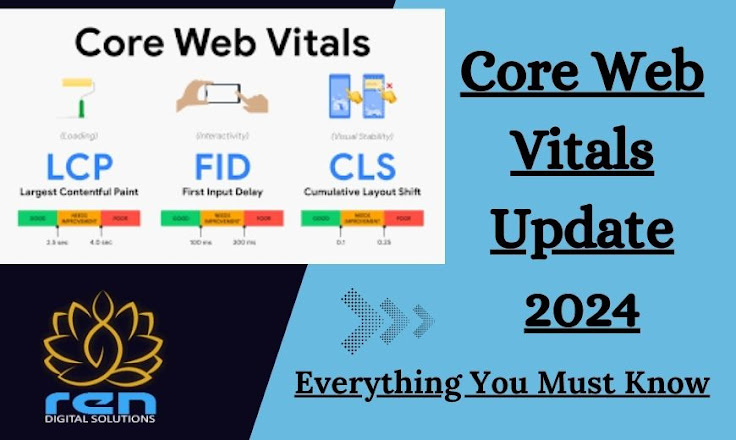The digital world thrives on user experience, and Google continuously refines its algorithms to prioritize websites that deliver the best experiences. Core Web Vitals (CWVs), introduced by Google in 2020, have become a cornerstone of SEO strategies. With the Core Web Vitals Update 2024, it’s crucial to understand the changes and adapt your website to maintain and enhance your search engine rankings.
This Article will walk you through what Core Web Vitals are, the updates in 2024, and actionable tips to optimize your website for this new benchmark.
What Are Core Web Vitals?
Core Web Vitals are a set of metrics that measure the user experience on a webpage, focusing on three primary aspects:
Largest Contentful Paint (LCP): Measures loading performance. A strong LCP score is attained when the page loads in 2.5 seconds or faster.
First Input Delay (FID): Measures interactivity. An ideal FID score measures below 100 milliseconds.
Cumulative Layout Shift (CLS): Measures visual stability. A good CLS score is less than 0.1.
These metrics provide a quantitative assessment of how users perceive their experience, and they are integral to page ranking factors in Google's algorithm.
What’s New in the Core Web Vitals Update 2024?
Google’s 2024 update introduces refinements to these metrics and emphasizes their role in ranking:
1. New Metric: Interaction to Next Paint (INP)
Replacing FID, the Interaction to Next Paint (INP) focuses on overall page responsiveness, measuring how quickly a website responds to user interactions like clicks, taps, or keyboard inputs. INP provides a more holistic view of interactivity compared to FID.
2. Stricter Benchmarks
Google is tightening the acceptable thresholds for CWVs. For example:
LCP must now be under 2.0 seconds for optimal performance.
INP should ideally be under 200 milliseconds.
CLS thresholds remain unchanged but will be more closely monitored.
3. Expanded Impact on Mobile Rankings
While Core Web Vitals were always critical for mobile, the update gives additional weight to mobile CWVs as part of Google's Mobile-First Indexing strategy.
4. Contextual Relevance
Google now adjusts CWV expectations based on the context of the website. For example, e-commerce sites may face stricter interactivity requirements than a blog site.
5. Focus on Sustainability
Google encourages website developers to optimize CWVs in ways that also reduce energy consumption, aligning with broader goals of sustainability in web development.
Why Core Web Vitals Matter More Than Ever
The Core Web Vitals Update 2024 is a wake-up call for website owners to prioritize user experience. Websites that fail to meet the updated benchmarks may see a drop in rankings, decreased organic traffic, and higher bounce rates. Conversely, meeting these standards can lead to:
Improved visibility on search engine results pages (SERPs).
Increased user engagement and retention.
Better conversion rates for e-commerce and lead generation.
How to Optimize Your Website for the 2024 Core Web Vitals Update
Staying ahead of the curve requires proactive measures. Here are practical steps to enhance your website's performance in light of the 2024 update:
1. Improve Largest Contentful Paint (LCP)
Optimize Images: Compress and use next-gen formats like WebP or AVIF. Implement lazy loading for non-critical images.
Upgrade Hosting: Use fast hosting services or content delivery networks (CDNs) to reduce server response time.
Reduce Render-Blocking Resources: Minimize JavaScript and CSS that delay content rendering.
2. Enhance Interaction to Next Paint (INP)
Optimize JavaScript Execution: Reduce the size of JavaScript files and remove unused code.
Reduce Main-Thread Blockages: Avoid long tasks that can delay user interactions.
Implement Efficient Event Handling: Ensure event listeners and handlers are optimized for responsiveness.
3. Minimize Cumulative Layout Shift (CLS)
Set Dimensions for Media: Always define width and height attributes for images, videos, and ads.
Preload Fonts: Use font-display: swap to prevent text layout shifts.
Avoid Injecting Content: Ensure dynamic content does not disrupt page stability.
4. Test and Monitor Performance
Use tools like Google’s PageSpeed Insights, Lighthouse, and Web.dev to regularly test your website's CWV scores.
Monitor metrics via Google Search Console, focusing on “Core Web Vitals” reports.
5. Prioritize Mobile Optimization
Implement responsive design to ensure your website performs well on all devices.
Minimize mobile-specific pop-ups or interstitials that disrupt user experience.
The Role of SEO in Core Web Vitals
While technical optimization is essential, CWVs must work in harmony with your broader SEO strategy:
Content Quality: Ensure your content is engaging, valuable, and well-structured.
Internal Linking: Improve navigation and reduce bounce rates by linking related pages.
Keyword Targeting: Combine technical SEO with keyword-optimized content for maximum impact.
Conclusion
The Core Web Vitals Update 2024 reinforces Google’s commitment to user-centric rankings. By focusing on key metrics like LCP, INP, and CLS, and optimizing for mobile and sustainability, you can stay competitive in search results. Whether you're running a personal blog or an e-commerce giant, now is the time to audit and improve your website's performance.
For tailored digital marketing and website optimization services, partner with the Best Digital Marketing Company in Crossing Republik, REN Digital Solutions. Let us help you thrive in the ever-evolving SEO landscape.




